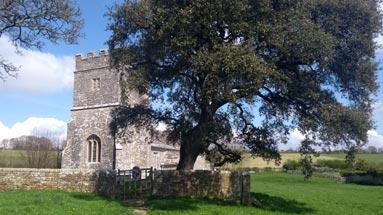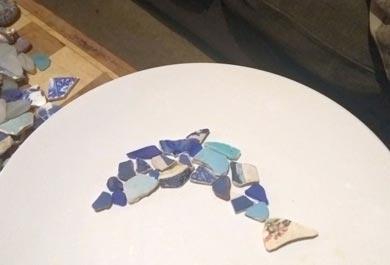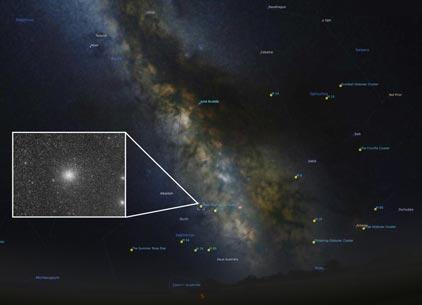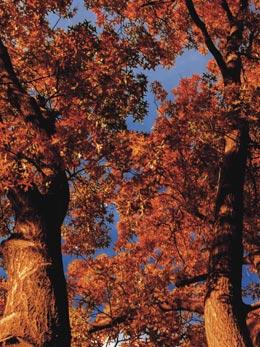
12 minute read
Down to earth
The Devil’s Door and the Mermaid
PAGAN VIEWS by JO BELASCO
Advertisement
Whitcombe church’s foundations are over a thousand years old. My pagan view is that it is a wonderful place to spend some time. The dedication of the ancient church is unknown and it is now in the care of The Churches Conservation Trust. I can’t help wondering who it was originally dedicated to. On the North Wall is a mural of St Christopher holding the Christ child. I knew St Christopher was the patron saint of travellers but I did not know that he particularly specialised in helping people across water. Perhaps that is why there is a painting of a mermaid in the same mural. Being part beast, medieval Christians used mermaids as shorthand for temptresses. Often depicted, as this one is, with a mirror indicating vanity and is that a comb in her other hand? Medieval congregations could not read, so often these images on the wall were used as pictorial lessons. There is such a lot of fascinating lore in churches and just as you think you have learnt the rough idea it changes in the next century. Whether you believe the origins of mermaids were from tipsy lonely sailors sighting manatees or water goddesses from other cultures I am sure you will agree it is unusual to find one in a church. Having just been reading about Oshun, a fresh water goddess, I am struck by the similarity of the mirror to the round ritual fan which Oshun is always depicted with. Circles are often employed as historical symbols of everlasting protection – I think I prefer this interpretation to the early churches. It’s amazing to think this church may once have entertained both Christians and Pagans. Pagans were originally only allowed in the north door, which has connotations of being less angelic than the other three cardinal points. Many churches in Dorset and throughout the UK have blocked up north entrances and Whitcombe church is no exception, as you can see here in the photo. The north entrance was said to be the exit of choice for the departing evilness when a baby was baptised! Why the north got this bad reputation in the first place is not clear. Probably partly due to the existence of the constellation Draco, the great serpent of the north, which ties up nicely with the Mermaid’s tail.
HISTORY LESSON: Whitcombe church and, left, the bricked-up Devil’s Door and, right, a fading mermaid mural
The West Dorset Magazine, July 1, 2022 45 Down to earth Wonders of my spectacular lavender hedge
Sally Cooke lives in Tolpuddle with her husband, two grown up sons and her spotty rescue dog. You can follow Sally on Instagram at Sparrows in a Puddle
The lavender hedge in my garden is at its spectacular best in July. It is covered in stunning scented purple flowers and constantly buzzing with bees. I established the hedge soon after we moved in, carefully potting on a mail-order tray of tiny plug plants until they were big enough to plant in the ground. A sunny position in our dry, free-draining soil has given the hedge the closest Tolpuddle can offer to the Mediterranean climate where lavender originates, and it has thrived. Every summer, the speed with which it changes from an unassuming woody grey-green hedge to something so vibrant and full of life takes my breath away. Its flowers are rich in nectar so they attract the bees, but it is mostly bumblebees that I see visiting it all summer rather than honeybees. Researchers have discovered that this is because the bumblebees have longer tongues and so can get at the nectar more efficiently from the tubular flowers. It also attracts butterflies, particularly the whites (maybe because it’s close to my vegetable patch), but also sometimes painted lady, small tortoiseshell and peacock. I’ve been out at dusk and seen moths feeding too, particularly a moth that sometimes migrates in great numbers from Europe in summer, the silver Y. Some of the common moths have names that describe how they look and the silver Y has a marking that looks distinctly like a silver letter Y on its forewing. By the end of July, the first of the lavender flowers will have set seed. I won’t cut off the dead flowers, instead I’ll leave the seeds for the birds. Apparently, the seeds might attract goldfinches, greenfinches and bullfinches but I know what birds to expect in my sparrow-dominated garden! I have sometimes seen a cloud of maybe thirty sparrows fly out of the hedge when disturbed. Lavender has been cultivated for more than two thousand years for its many varied uses. The Romans brought it to Britain, having recognised its healing and antiseptic properties, and its name is thought to come from the Latin ‘lavare’ which means ‘to wash’. Today, as well as its use in soaps and lotions, its oils can improve sleep, boost mood, relieve pain and heal skin. I know some people even gather the flowers to mix with sugar to make lavender shortbread, but I tend to leave mine to the wildlife!
Away with the theories of fairies: It’s mushrooms
JOHN WRIGHT is a naturalist and forager who lives in rural West Dorset. He has written eight books, four of which were for River Cottage. He wrote the award-winning Forager’s Calendar and in 2021 his Spotter’s Guide to Countryside Mysteries was published.
I hesitate to disappoint the romantically inclined, but the rings of mushrooms one sees in grass, and sometimes woodland, are not created by fairies. Sorry. Everything in the past was a miracle of one sort or another so fairies or goblins dancing in a circle seemed as likely as anything else. It was not until the late 18th century when the great botanist, physician and allround genius William Withering dug one up and noticed the white fibres extending below the mushrooms to form a ring themselves. Mushroom rings are caused by mushrooms – or rather, the mass of fungal mycelium that is permanently in the soil whether the mushrooms are present or not. But why a ring? It is simply a pattern of growth. Spores produced by mushrooms located elsewhere settle in the soil and germinate. They produce fine threads called hyphae which will eventually join to form a mass of fungal matter called a mycelium. This obviously has to feed to grow at all, doing so by exuding enzymes into the soil that convert dead organic matter into sugars that can be absorbed. In its extreme youth the mycelium will form a small disc. This disc then grows outwards because there is (obviously) nowhere else to grow and dies out in the middle of the expanding disc as there is nothing left there to eat. This inevitably produces a ring of mycelium on which the mushrooms will eventually form. You may have noticed that some such rings are visible as rings of lush grass, even in the absence of mushrooms. This grass is just behind the advancing ring and caused by the release of nutrients from the feeding activity of the fungus. For the mushroom-hunter such rings are helpful because they will often be visible from some distance and at almost any time of year. They are even visible on Google Maps or Earth. To get you started, zoom in to the grassy area at Portland Bill to the east of the car park and you will be able to see dozens of them. One species at least, the very tasty Fairy Ring Champignon, Marasmius oreades, is visible as a ring of lush grass inside a ring of dead grass. At barely an inch high it would have difficulty spreading its spores to the four winds in tall grass so, taking no prisoners, it simply kills it by releasing hydrogen cyanide into the soil.
BEACHCOMBING with JO BELASCO BA Hons History of Architecture and Design

In the same way as a green screen is used to highlight the human skin in movies, the colour blue stands out on beaches. Yeah, it’s a bit odd as the sky and sea are blue (ideally) but on the ACTUAL surface of the beach there is little blue save the blue of pottery shards or sea glass. If you just have a wander and spot a shard colourside-up that is very lucky. As most times when one finds a shard you turn it over only to find it is white and plain on both sides. But occasionally you get pattern and a story. Years ago I found a shard with a picture of part of Bristol suspension bridge. I googled it and found out all sorts of interesting things. I put it for sale on a Facebook site specifically for selling shards with a potted history. A New Yorker and teacher in engineering bought it and said she intended to have it made into a piece of jewellery. When you sell beachcombing items its expected that you put a coin by the item for scale, I have used an American coin here as the US is where most buyers seem to hail from. It is also good practice to take photos of the shards on both sides. It didn’t sell for much but being stuck at home it was just nice to make connections out in the big world and dip into architectural history too. I also find pottery shards in the remnants of old middens (small pre-council rubbish dumps). As you can see by the blue pottery shards in my hand they are pretty but with jagged edges. Not nearly so sought after as the smooth edges crafted by the sea which look and feel so much better in jewellery or art of any kind. On Facebook groups the Queen of Shards is Wendy’s Scottish Beach Finds. Warning: After looking at Wendy’s finds it is normal to feel green with envy and search Rightmove for East Scotland. The hunt is the biggest delight for me. Only rarely do I get stuck into a project. I find it hard to commit my beautiful wild shards into a permanent situation like a framed picture. Sometimes I just get a plate and tinker with making different animals and scenes but I usually prefer to leave the pieces loose to make something new another day.
FIT FOR PORPOISE: A dolphin made of sea shards and, inset, example of rough edged pottery shards not softened by the sea
Blue really is the colour for your pottery shard findings
SMOOTH: An example of smooth-edged shard and, right, a shard showing part of Bristol suspension bridge with a US coin for scale
The West Dorset Magazine, July 1, 2022 47 Down to earth It’s all about the planets during July
Kevin Quinn is a Dark Sky Custodian for the Cranborne Chase Dark Sky Reserve who lives in Piddletrenthide. Read his blog at theastroguy.wordpress.com

As I discussed in my last piece (WDM issue 9), and even though we’re now past the solstice, the nights are still way too bright and short for stargazing, and the opportunities, although still there, are really only for those able to stay up late, or those up very early in the morning. The early mornings throughout July are all about the planets. All seven will be visible at the beginning of the month, just before dawn, with Venus initially very close to the Hyades star cluster in Taurus. Mercury will gradually drop lower to the horizon as the days go by. On the morning of July 22, the waning crescent moon will be just over a degree from the planet Uranus, with Mars only about six degrees to its right (that’s about the width of your three middle fingers held up at arm’s length). TREE SURGERY & The moon will continue its journey across the sky until GARDEN MAINTENANCEthe very thin waning crescent will meet up with 07826 030706 Venus. Mars and Uranus will likewise continue their stevettg@hotmail.comrespective journeys across the morning sky, until they pass around one degree (that’s about twice the diameter of the full moon) from each other on the morning of August 2. Night owls can continue to look forward to watching the Milky Way emerge as darkness falls. The best time during July is either towards the beginning or during the last two weeks of the month, when the moon’s not around to spoil the show. Look out for the red supergiant Antares low in the south in the constellation of Scorpius. A likely supernova candidate (though probably not during our lifetimes), this massively bloated star absolutely dwarfs our sun. The area around Scorpius and Sagittarius is absolutely full of open and globular star clusters, including one of my favourites: Messier 22. This bright and massive globular cluster, containing approximately 500,000 stars, is visible to the naked eye, is the size of the full moon (about half a degree, or your extended little finger held at arm’s length), and is simply stunning in binoculars or a telescope. There really is so much to see in the heart of the Milky Way at this time of year, that it really is worth the effort at least once during the summer. I’d recommend packing a barbecue, a flask of tea or coffee, and a couple of deckchairs and head down to Portland Bill, or West Bexington, Ringstead Bay, or the Isle of Purbeck viewpoint beyond Creech and make an evening of it. If staying up late or getting up early isn’t for you, there’s always the moon


SKY-WATCHING: Highlights of the summer sky (July’s first quarter is on the 7th, full on the 13th, last quarter on the 20th and new again on the 28th), and noctilucent clouds to enjoy. One final thing to look forward to, towards the end of July, is the return of planets to the evening sky, starting with Saturn, which will just clear the southeastern horizon around 9pm. I’ve missed the opportunity to observe the planets lately, and am looking forward to their return.











